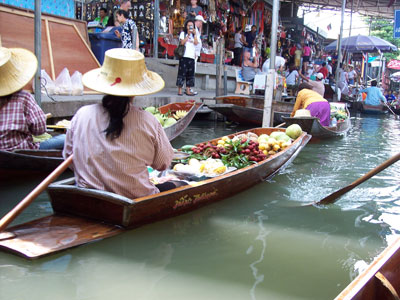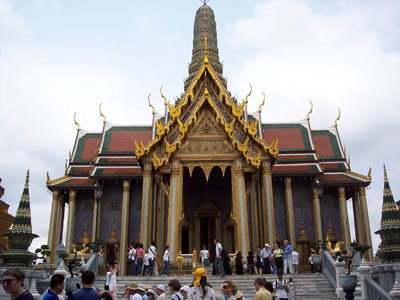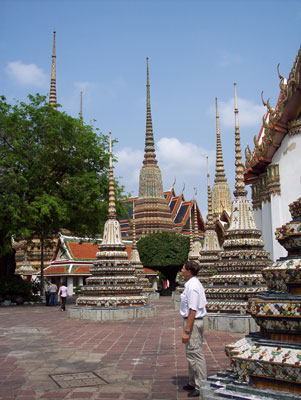Bangkok revisited
by Randy Keck, part 1 of 3 on Thailand
Despite my many travels to Asia over the years, the visit I made to Bangkok in March ’08 was my first since the latter stages of the Viet Nam War. This long-awaited Bangkok reunion was part of an 11-day Thailand visit hosted by Value World Tours (an ITN advertiser) and the Tourism Authority of Thailand.
“Thainess” — even in Bangkok
While the primary focus of my Thailand visit was a river cruise in central and northern Thailand, it was enlightening to experience Bangkok’s emergence as one of the great modern cities of Asia. The city has accomplished this while retaining, in my opinion, its greatest asset: its Thai essence.
It seems the popular term for this today is “Thainess,” generally defined as the art of Thai living and, perhaps more specifically, the Thai philosophy of life, values and living behaviors.
Many visitors and particularly repeat visitors to Thailand today openly admit that their primary attraction to the country is experiencing the naturally accepting, gentle, loving Thai people and their way of life, indeed a foreign concept in the modern Western world.
I found this addictive, gracious Thai spirit to prevail in all of the regions of Thailand that I visited on my journey. It is perhaps best summed up by paraphrasing a Thai tourism official’s recent observation: “Many of our visitors seem to be more interested in ‘life seeing’ than sightseeing.”
Bangkok highlights
One could spend weeks exploring Bangkok in detail, so my two full days were necessarily packed with some of the main attractions.
My first morning in the capable hands of my guide, Mea, was consumed with educational visits to two of Bangkok’s finest and most unusual wats (temples) and the Grand Palace. Our first stop was in Chinatown at the impressive Wat Trimitr, or Temple of the Golden Buddha, featuring a 5½-ton, 700-year-old Buddha image composed of gold.
Next up was Wat Po, or Temple of the Reclining Buddha, neighboring the Grand Palace. It is the most extensive temple in the city, with its colossal 46-meter-long Reclining Buddha and sole, which reveals 108 auspicious characteristics of the “true” Buddha. Wat Po was the first center of public education in Thailand and today is an important teaching center for Thai massage.
The Grand Palace, sprawling over 60 decorative acres, was our final stop and revealed period Asian architecture at its finest. Many ornate temples and other structures adorned the extensive grounds, home to the Emerald Buddha, Thailand’s most revered Buddha image.
This was to be the first of many days of continuous shoe removal, as is required before entering each individual temple within the larger temple complexes. Wearing easy slip-off/on footwear is recommended.
Floating gardens
On my second morning, Mea and I headed out of Bangkok into the countryside, briefly visiting a salt farm and a coconut sugar farm en route to one of Thailand’s colorful floating markets at Damnoen Saduak.
On arrival at the boat landing, we boarded a longtail boat and began speeding through the narrow waterways, which provided entertaining glimpses of the rural canal-front dwellings and lifestyles of the locals.
On arrival at the markets, we transferred to a small sampan and were thrust into the waterway traffic jam central that is the reality of floating markets today. While touristy, the floating markets offer a colorful array of sights and sounds and are an undeniable testimonial to Thai patience.
The farmers and merchants display a wide range of tropical fruits, vegetables and other food items as well as crafts and myriad souvenirs. Good-natured bargaining is the custom, and my new Polo sunglasses secured at less than one-tenth the mall price may not be the “real” thing but have proved to be very good quality.
After enjoying a riverside lunch stop we returned to the city, where I enjoyed roaming on my own plus, in the evening, my first in-country experience with Thai massage.
My hotel, the Grand Mercure Park Avenue (30 Sukhumvit, Soi 22), was centrally located and a close walk from a wide range of shopping experiences, two scenic city parks and the Skytrain. My upgraded luxury room (about $120) was without fault.
Leaving much for my next visit, my Bangkok sojourn was too quickly at an end.
Before you travel
For information regarding touring Thailand, including taking river cruises, contact Value World Tours (Fountain Valley, CA; 800/795-1633, e-mail cruise@valuecruises.net or visit www.valuecruises.net).
For information concerning Thailand, including their great range of general- and special-interest brochures and maps, contact the Tourism Authority of Thailand (611 North Larchmont Blvd., First Floor, Los Angeles, CA 90004; 323/461-9814, e-mail tatla@ix.netcom.com or visit www.tourismthailand.org/la).
In next month’s column, I describe a 4-day/3-night river cruise in central Thailand and exploring the infamous World War II Death Railway.
You may write or e-mail Randy c/o ITN.



